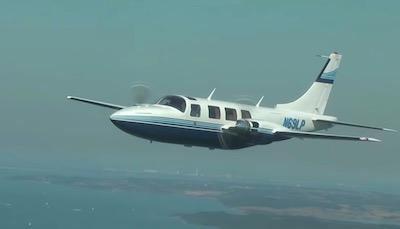Airplane Was Apparently Misfueled With Jet A
The NTSB has released a preliminary report from an accident which occurred on October 5, 2019 about 1637 eastern daylight time involving a Piper Aerostar 602P, N326CW. The aircraft departed from Kokomo Municipal Airport (KOKK), Kokomo, Indiana, and impacted a field about 3.6 miles south of the airport. The airplane was destroyed by impact forces. The airline transport pilot sustained fatal injuries. The airplane was registered to Indiana Paging Network Inc and was operated by the pilot under Title 14 Code of Federal Regulations Part 91 as a business flight that was not operating on a flight plan. Visual meteorological conditions prevailed for the flight while departing from KOKK.

On the day of the accident, the flight departed from Peter O Knight Airport (KTPF), Tampa, Florida, about 0645 and arrived at OKK about 1027. The purpose of the flight was for the pilot, who was employed by In Flight Review, Inc, based in Tampa, Florida, to provide Piper PA-42 Cheyenne recurrent training to a customer based at KOKK.
According to the airport employee who fueled the airplane, he asked the pilot of N326CW, while on approach to the airport, if he wanted jet fuel, and the pilot said "yes." He said the he asked the pilot if he wanted jet fuel because the airplane looked like a jet airplane. When the airplane arrived, the employee pulled the Jet A fuel truck out and parked it in front of the airplane while the pilot was still inside the airplane. The employee said that he asked the pilot again if he was wanted jet fuel, and the pilot said "yes." The employee fueled the airplane with about 163 gallons of Jet A from the fuel truck. The employee said that he was able to orientate the different shaped nozzle (relative to the 100 low lead fuel truck nozzle) from the Jet A fuel truck by positioning it 90 degrees over the wing fuel tank filler necks and about 45 degrees over the fuselage filler necks. He said the he initially spilled about one gallon of fuel during refueling and adjusted his technique so subsequent fuel
spillage was minimal.
The Jet A fuel truck had "JET A" on its left, right, and rear sides.
The employee that was inside the fixed base operator building about 1620 heard the engines start. After the engines started, the engines sounded "typical." He said that he did not hear any radio transmissions from the pilot during his departure and did not hear an engine runup.
The pilot, who received recurrent training from the accident pilot, stated the accident pilot began training right away beginning about 1045. They completed training and it was after 1630 when the pilot drove the accident pilot to N326CW. The pilot said the accident pilot visually checked the fuel tanks of the airplane and gave a "thumbs-up" to the pilot. The pilot did not stay for the remainder of the accident pilot's preflight and drove off. The pilot heard the engines start and "they sounded normal." The pilot did not see the takeoff. The pilot said the winds favored runway 14, which was in use on the day of the accident.
A witness stated that she saw a "low flying" airplane flying from north to south. The airplane made a "sharp left turn" to the east. The left wing "dipped low" and she then lost sight of the airplane but when she approached the intersection near the accident site, she saw the airplane on the ground.
Post-accident examination of the airplane revealed the airplane wreckage path was about 328 ft in length along an approximate heading of 046° on a dry and hard surfaced fallow bean field. Components of the left side of the airplane were near the southwestern portion of the wreckage path. The wreckage and the wreckage path displayed features consistent with an accelerated stall.
The examination revealed the presence of a clear liquid consistent in color and order with that of Jet A in a fuselage tank and in the fuel lines leading to the fuel manifolds of both engines. Several of the engine spark plugs exhibited damage consistent with detonation. Flight control continuity was confirmed. The landing gear was in the retracted position.
NATA released a statement following the release of the preliminary report. “The National Air Transportation Association (NATA) was saddened to learn of a recent preliminary report of a fatal aircraft accident related to a suspected misfueling. Aircraft misfuelings are preventable through proper training and eliminating these incidents is a top priority for NATA and our membership. NATA’s Misfueling Prevention Program can be accessed free of charge at www.preventmisfueling.com and includes learning tracks for line service professionals, customer service representatives, FBO managers, and pilots,” stated NATA president Gary Dempsey. “NATA urges ALL FBOs, regardless if you are a member of NATA, and pilots to use this complimentary resource NATA created for the industry. NATA is dedicated to working with our members, partners, and other industry stakeholders to educate the aviation community and keep our skies safe and secure.”
(Source: NTSB and NATA. Image from YouTube video posted by user Graham P. Not accident airplane)
 ANN's Daily Aero-Term (04.26.24): DETRESFA (Distress Phrase)
ANN's Daily Aero-Term (04.26.24): DETRESFA (Distress Phrase) ANN's Daily Aero-Linx (04.26.24)
ANN's Daily Aero-Linx (04.26.24) Airborne 04.22.24: Rotor X Worsens, Airport Fees 4 FNB?, USMC Drone Pilot
Airborne 04.22.24: Rotor X Worsens, Airport Fees 4 FNB?, USMC Drone Pilot Airborne 04.24.24: INTEGRAL E, Elixir USA, M700 RVSM
Airborne 04.24.24: INTEGRAL E, Elixir USA, M700 RVSM Airborne-NextGen 04.23.24: UAVOS UVH 170, magni650 Engine, World eVTOL Directory
Airborne-NextGen 04.23.24: UAVOS UVH 170, magni650 Engine, World eVTOL Directory



